


![]() Effectively and efficiently tapping into all available health care resources when rehabilitation is necessary, so that injured workers can safety return to work as soon as possible.
Effectively and efficiently tapping into all available health care resources when rehabilitation is necessary, so that injured workers can safety return to work as soon as possible.
While our goal is to prevent workplace injuries from occurring, when they do occur we are there to help the worker recover from their injury and assist in a safe return to work as early as possible. Effective return-to-work (RTW) practices and appropriate and timely medical care are fundamental to getting workers back to the job safely after an illness or injury.
Claim Duration
WorkSafeNB is committed to helping New Brunswickers recover from a workplace injury so that they can return not only to their job, but also to the things that they love to do most as quickly as possible. Being off work for extended periods of time, as we have seen with our longer lost-time claims, is not good for the worker, their family, employer or the province’s economy. Making safe, sustainable work arrangements for recovering workers takes teamwork. Workers, employers, and health care providers all have important contributions to make and are critical partners as we strive to improve duration measures.
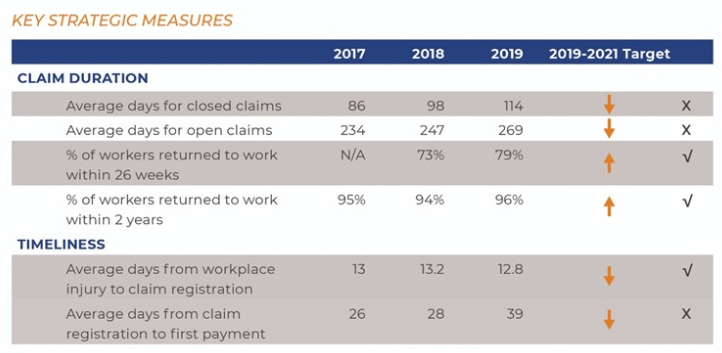 The average duration of lost-time claims has increased in recent years. Legislative changes in 2015 resulted in unintended consequences whereby some workers with health conditions unrelated to a workplace injury continued to receive workers’ compensation benefits. Following legislative changes to mitigate this issue in December 2018 as well as new duty-to accommodate legislation in 2019, we have seen improvement and we can expect to see more in claim duration over the coming years. Traumatic psychological injuries as a result of a workplace accident and workplace injuries that require the worker to be retrained in a new career are particularly challenging and are significant contributors to the average duration of open claims.
The average duration of lost-time claims has increased in recent years. Legislative changes in 2015 resulted in unintended consequences whereby some workers with health conditions unrelated to a workplace injury continued to receive workers’ compensation benefits. Following legislative changes to mitigate this issue in December 2018 as well as new duty-to accommodate legislation in 2019, we have seen improvement and we can expect to see more in claim duration over the coming years. Traumatic psychological injuries as a result of a workplace accident and workplace injuries that require the worker to be retrained in a new career are particularly challenging and are significant contributors to the average duration of open claims.
Getting New Brunswickers back to work is an important part of recovery. But achieving return to work success with our long-term clients will inevitably increase the average duration of closed claims. This is due to lengthy claims now being included in this average. And while this increase seems contrary to our objective, our return to work efforts are trending in the right direction, as demonstrated in the following graphs.
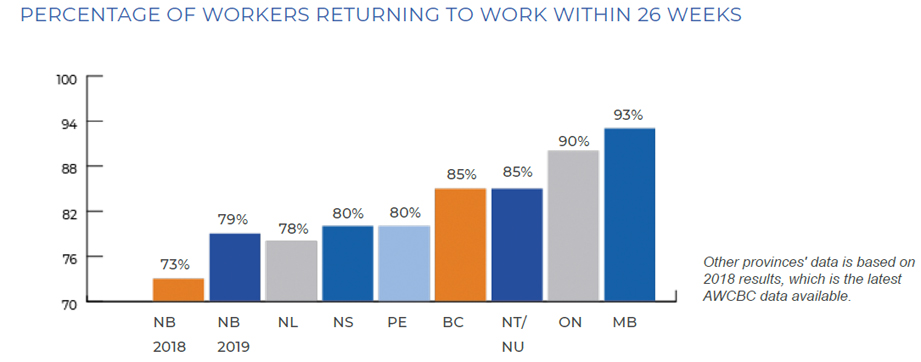
In addition to the average number of days for open and closed claims, WorkSafeNB measures the percentage of workers back on the job at 26 weeks and again at two years. We benchmark our results against ourselves, as we are committed to continuous improvement, and also against other jurisdictions. Today, we compare favourably to our counterparts across the country and we are proud of the 6% increase in workers back to work at 26 weeks compared to last year and the 2% increase in workers returned at two years.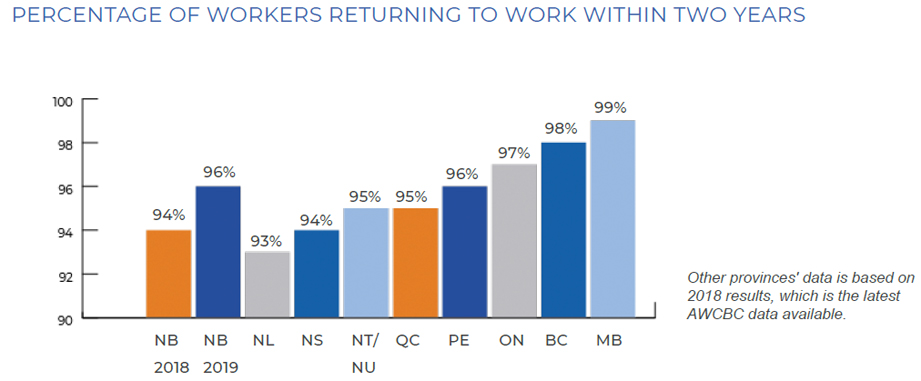
Timeliness
Being hurt at work is stressful enough – injured workers don’t need the added anxiety of worrying over access to treatment and lost income. Quickly adjudicating claims and providing injured workers with the required medical aid along with their wage-loss benefits is important to help alleviate worry and allow them to better focus on their recovery.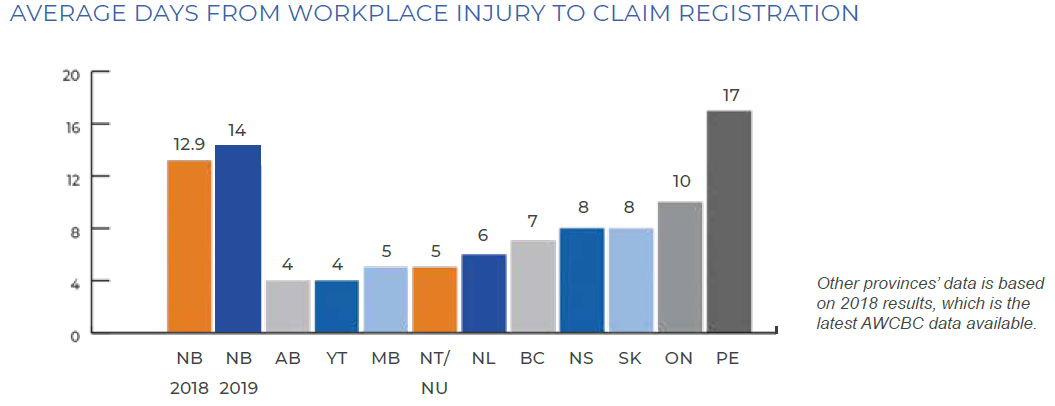
Fast access to treatment and rehabilitation is a priority to ensure recovery. Getting injured workers connected to the treatment and supports they need requires employers, workers and the medical community to notify us and provide necessary information as quickly as possible. WorkSafeNB’s legislation requires notification of accidents within three business days. In late 2019 legislation passed that allows us to issue administrative penalties to employers who are not compliant in reporting. This new tool, along with implementing the Auditor General’s recommendation to separate our accident reporting form - Form 67 - to allow employers and workers to report an accident independently will improve these results.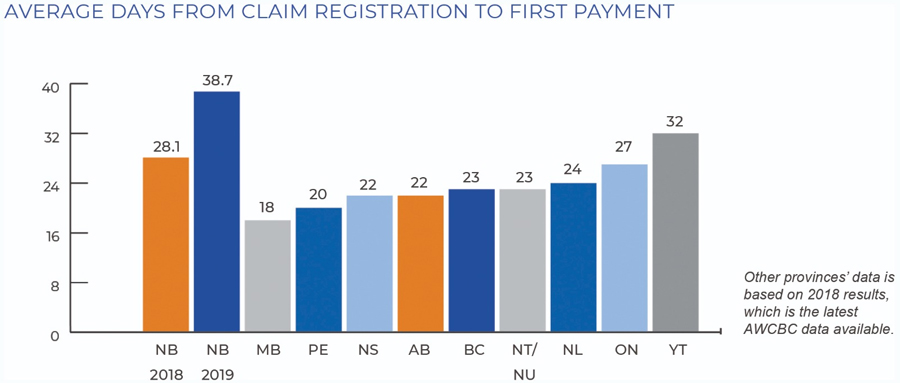
We are disappointed with the number of days it takes for our injured workers to receive payment once the claim is registered. We know how important payment is to workers and their families and our results are unacceptable. At the time of writing this report, the root cause of the delay had been identified and process improvements are being implemented. We will do better.
Supporting our key strategic measures new legislation to facilitate return to work
Research over many years is conclusive – getting injured workers back to work as soon as safely possible is the best way to achieve effective recovery. It helps them stay active, renews a sense of purpose, is good for their physical and mental health, and provides financial stability.
It also benefits employers, as they keep productivity loss to a minimum, keep a skilled and experienced worker, reduce the costs of recruiting new talent, and reduce claim costs that, in turn, can reduce assessment premiums. And, the workers’ compensation system also benefits from a culture of return to work, or recovering while at work, following a workplace injury, as claim duration is a key cost driver of the system.
Throughout 2019, WorkSafeNB built on the momentum provided by this research and the Auditor General’s recommendations to focus on helping workplaces understand the importance of return to work programs.
Bill 27 requires employers to:
While most New Brunswick employers already supported their employees in these critical areas, this legislative amendment solidified and highlighted the importance of workplace accommodation.
Working to Well – A Return to Work toolkit for small businesses
New Brunswick is made up largely of small to medium-sized employers. In fact, 81% of our province’s employers have approximately 12 or fewer employees. For such employers, workplace injuries and illnesses happen few and far between. While this is good news, most employers do not have the tools and resources in place to act quickly when an injury happens.
That is why in 2019 we launched An Employer’s Guide to Return to Work and Disability Prevention to help employers manoeuvre the return-to-work (RTW) process. This guide helps you develop a workplace that supports work as part of injury and illness recovery – before a workplace injury happens.
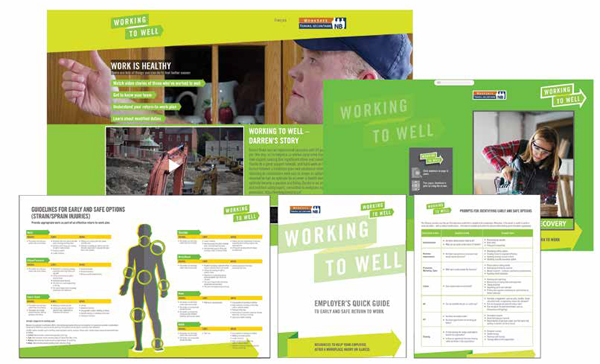
New medical form focused on functional abilities specialized teams for complex claims
As part of our ongoing commitment to effective recovery, we introduced a new medical reporting process that will further help employers develop early and safe return-to-work (RTW) plans.
After research and discussion with the New Brunswick and Canadian medical communities and other compensation boards across the country, WorkSafeNB has created a new and improved medical form. Medical Form 8-10 encourages stay-at-work and early-and-safe- return-to-work for workers.
Medical Form 8-10 has some key improvements:
Employers will have a thorough understanding of a worker’s abilities and limitations so supervisors can better support workers with safe and productive duties.
By their nature, complex claims such as traumatic psychological injuries (TPI) last longer and contribute to longer duration. The management of these claims is a growing challenge and a significant barrier to return to work. We recognized a need to improve how we support these workers toward a positive outcome and explored best practices to more effectively manage claims where psychosocial barriers exist. We also launched a new team dedicated to traumatic psychological injuries.
The TPI team aims to ensure quicker adjudication for these claims that were among the longest; that claim-related decisions are consistent with current legislation; and, identifies opportunities for workers with a workplace psychological injury to safely return to work by focusing on the functional abilities.